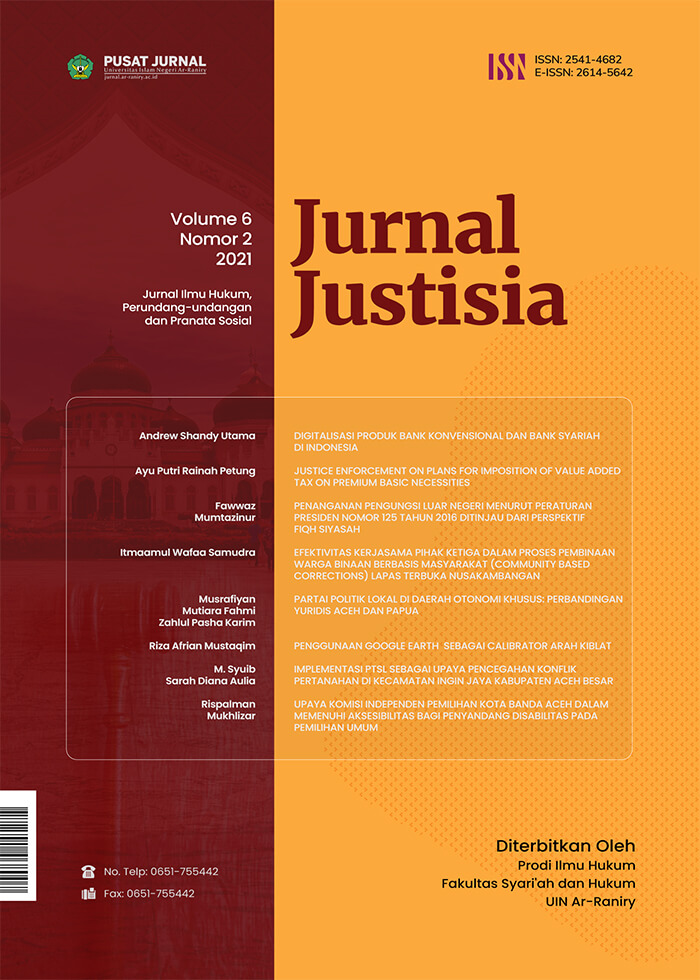Penggunaan Google Earth Sebagai Calibrator Arah Kiblat
DOI:
https://doi.org/10.22373/justisia.v6i2.11537Abstract
Qibla direction calibration is something that is very urgent in order to achieve accuracy and accuracy in facing the Qibla. Technological developments in the industrial era 4.0 require the use of technology that is easier to carry out the calibration process. Google earth which displays a virtual image of the actual earth can be an alternative in fulfilling this. This study provides a detailed description of the use of Google Earth as a Qibla direction calibrator. The method used in this research is descriptive analytical with a scientific approach. The results of this study indicate that google earth can be used as an alternative to calibrate the Qibla direction. By knowing in detail the latitude and longitude coordinates where Google Earth can determine the Qibla direction by using the measure distance and area feature (measuring distance and area) drawn straight to the Kaaba position. With regard to accuracy, as long as the location can show the updated position on Google Earth, it will be easier to calibrate, with fairly accurate results.
References
A. Jamil, Ilmu Falak (Teori & Aplikasi); Arah Kiblat, Awal Waktu, dan Awal Tahun (Hisab Kontemporer), Jakarta: Amzah, 2009.
Ahmad Izzuddin, “Metode Penentuan Arah Kiblat Dan Akurasinya”, disampaikan pada Conference Proceedings; AICIS IAIN Sunan Ampel Surabaya, 2012.
Alfirdaus Putra, Cepat & Tepat Menentukan Arah Kiblat, Yogyakarta; Penerbit Elmatera, 2015.
Anisah Budiwati, “Fiqh Hisab Arah Kiblat : Kajian Pemikiran Dr. Ing Khafid Dalam Software Mawāqit”, Jurnal Unisia, Vol. XXXVI No. 81 Juli 2014.
Anisah Budiwati, “Tongkat Istiwa‘, Global Positioning System (Gps) Dan Google Earth Untuk Menentukan Titik Koordinat Bumi Dan Aplikasinya Dalam Penentuan Arah Kiblat”, Jurnal Al-Ahkam, Vol. 26, No.1, 2016.
Burhan, “Penetapan Arah Kiblat melalui Media Online : Google Earth dan Qibla Locator, pdf.
Dewi Arita dan Andri Pranolo, “Pemanfaatan Aplikasi Google Earth Sebagai Media Pembelajaran Gografis Menggunakan Metode Image Enhancement”, dalam Simposium Nasional RAPI XIII, 2014.
Efistek.com, Menjelajah Dunia dengan Google Earth dan Maps, Bandung: CV. Yrama Widya, 2006.
Muh. Ma’rufin Sudibyo, Sang Nabi Pun Berbutar; Arah Kiblat dan Tata Cara Pengukurannya, Solo: Tinta Medina, 2011.
Fatwa MUI Nomor 03 Tahun 2010 Tentang Kiblat
Fatwa MUI Nomor 05 Tahun 2010.
Gatty Ardyodyantoro, “Pemanfaatan Google Earth Dalam Pembelajaran Geografi Untuk Meningkatkan Hasil Belajar Siswa Kelas X Sma Widya Kutoarjo”, Skripsi Diajukan kepada Fakultas Ilmu Sosial Universitas Negeri Yogyakarta, 2014.
Irwan Gumilar, dkk., “Algoritma Penentuan Dan Rekontruksi Arah Kiblat Teliti Menggunakan Data Gnss” Jurrnal Geomatika, vol. 25, no.2 November 2019.
Jayusman, “Akurasi Metode Penentuan Arah Kiblat: Kajian Fiqh Al-Ikhtilaf Dan Sains”, Jurnal Asas, Vol.6, No.1, Januari 2014.
Khalifatus Shalihah, “Pandangan Tokoh Agama Terhadap Tingkat Akurasi Arah Kiblat Masjid-Masjid Se-Kecamatan Batu Layar Kabupaten Lombok Barat Menggunakan Istiwaaini”, Vol. 2, No. 2 Desember 2020.
Mohd. Kalam Daud, Arah Kiblat dan Waktu Salat, Diktat Ilmu Falak Jilid 1, Fakultas Syariah dan Hukum UIN Ar-Raniry, 2017.
Muh. Rasywan Syarif, “Problematika Arah Kiblat Dan Aplikasi Perhitungannya”, Vol. 9, No. 2, Desember 2012.
Mustofa Kamal “Teknik Penentuan Arah Kiblat Menggunakan Aplikasi Google Earth Dan Kompas Kiblat RHI”, Jurnal Madaniyah, vol. 2, 2015.
Slamet Hambali, Ilmu Falak 1, Semarang: Pascasarjana IAIN Walisongo, 2012.
Riza Afrian Mustaqim, Ilmu Falak, Banda Aceh: Syiah Kuala University Press, 2021.
T. Saksono, Fulazzaky, M. A., & Sari, Z., “Geodetic Analysis of Disputed Accurate Qibla Direction”, Jurnal Appl Geodesy, 2018.
Toyyib, Menghitung Arah Kiblat dengan Menggunakan Rumus Segitiga Bola, Journal Pengajaran Sains, Volume 1, MAN Cikarang, Cikarang Utara, Kabupaten Bekasi.
Downloads
Published
Issue
Section
License
The Authors submitting a manuscript do so on the understanding that if accepted for publication, copyright of the article shall be assigned to Jurnal Justisia : Jurnal Ilmu Hukum, Perundang-undangan dan Pranata Sosial, Ar-Raniry State Islamic University, Indonesia as the publisher of the journal.
Jurnal Justisia : Jurnal Ilmu Hukum, Perundang-undangan dan Pranata Sosial right of first publication with the work simultaneously licensed under Creative Commons Attribution-ShareAlike 4.0 International License (CC BY-SA 4.0) that allows others to share (copy and redistribute the material in any medium or format) and adapt (remix, transform, and build upon the material) the work for any purpose, even commercially with an acknowledgment of the work's authorship and initial publication in Jurnal Justisia : Jurnal Ilmu Hukum, Perundang-undangan dan Pranata Sosial. Authors are able to enter into separate, additional contractual arrangements for the non-exclusive distribution of the journal's published version of the work (e.g., post it to an institutional repository or publish it in a book), with an acknowledgment of its initial publication in Jurnal Justisia : Jurnal Ilmu Hukum, Perundang-undangan dan Pranata Sosial. Authors are permitted and encouraged to post their work online (e.g., in institutional repositories or on their website) prior to and during the submission process, as it can lead to productive exchanges, as well as earlier and greater citation of published work (See The Effect of Open Access).

